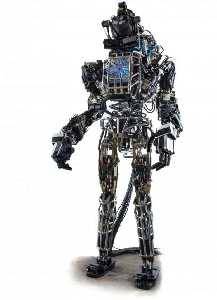Articles >>
DARPA`s ATLAS Robot Unveiled
Category: Robots

On Monday, July 8, 2013, the seven teams that progressed from DARPA’s Virtual Robotics Challenge (VRC) arrived at the headquarters of Boston Dynamics in Waltham, Mass. to meet and learn about their new teammate, the ATLAS robot. Like coaches starting with a novice player, the teams now have until late December 2013 to teach ATLAS the moves it will need to succeed in the DARPA Robotics Challenge (DRC) Trials where each robot will have to perform a series of tasks similar to what might be required in a disaster response scenario. These seven teams are not starting from scratch. Thanks to the physical modeling of the DRC Simulator, the software algorithms that were successfully employed by teams in the VRC should transfer with minor tuning to the ATLAS hardware. ATLAS is one of the most advanced humanoid robots ever built, but is essentially a physical shell for the software brains and nerves that the teams will continue to develop and refine. That software, and the actions of a human operator through a control unit, will guide the suite of sensors, actuators, joints and limbs that make up the robot. The six-foot-two, 330-pound ATLAS is capable of a range of natural movements and is equipped with:
In addition to the robot, the winning teams from the VRC will receive funding from DARPA and ongoing technical support from Boston Dynamics, the developer of ATLAS. “The Virtual Robotics Challenge was a proving ground for teams’ ability to create software to control a robot in a hypothetical scenario. The DRC Simulator tasks were fairly accurate representations of real world causes and effects, but the experience wasn’t quite the same as handling an actual, physical robot,” said Gill Pratt, program manager for the DARPA Robotics Challenge. “Now these seven teams will see if their simulation-honed algorithms can run a real machine in real environments. And we expect all teams will be further refining their algorithms, using both simulation and experimentation.” In June, the DRC program management staff also visited the seven Track A teams, those funded to build both hardware and software, to evaluate their platform design-and-build progress. The teams presented the details of their designs, hardware components, operator control strategies and, in some cases, completed robots. Based on the results of that Critical Design Review, DARPA selected the following six teams to advance to the DRC Trials with continued DARPA funding (in alphabetical order by team lead):
“We have dramatically raised the expectations for robotic capabilities with this Challenge, and brought together a diverse group of teams to compete,” said Pratt. “The progress the Track A teams have made so far is incredible given the short timeline DARPA put in place. From here out, it’s going to be a race to the DRC Trials in December, and success there just means the qualifying teams will have to keep on sprinting to the finish at the DRC Finals in 2014.” The six Track A teams, seven VRC winning teams and an unknown number of unfunded, Track D teams and their robots will compete for the first time in December 2013 at the Homestead-Miami Speedway in Homestead, Fla., site of the DRC Trials. The competition will be a unique spectator event open to the public. |
FLIR Wins U.S. Army Heavyweight Robot Contract Worth Up to $109M
06.12.2019
BAE Systems unveils Robotic Technology Demonstrator Vehicle at AUSA
15.10.2019
Kapitan UGV has passed the tests in Russia
30.07.2019
PSC-STN ATLAS ELEKTRONIK (M) SON BHD
Defense Advanced Research Projects Agency - DARPA
aEgis Robot (Remote controlled weapon station)
aEgis II Robot (Remote controlled weapon station)
Super aEgis I Robot (Remote controlled weapon station)
Super aEgis II Robot (Remote controlled weapon station)
UGV-RB Battle Robot (Robot, Unmanned Vehicle)
Discuss
